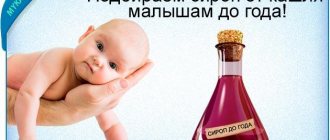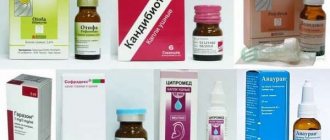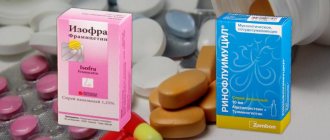Surgical intervention should not be delayed in the following cases:
- if the child cannot breathe fully through the nose;
- poor sleep in the baby due to snoring and breathing problems. Especially if shortness of breath occurs and the worst thing is short-term apnea, that is, cessation of breathing;
- when a child begins to hear poorly and his middle ear often becomes inflamed;
- repeated episodes of inflammation of the paranasal sinuses;
- with the so-called “adenoid” face formed. But it is better, of course, not to let this happen and to perform the operation before irreversible changes in the bones of the skull occur;
- prolonged bleeding from the nasal cavity.
If the above conditions do not yet exist, then it is necessary to try to cure the child’s adenoids without surgery.
In ancient times, when adenoids appeared, they were necessarily removed. Therefore, your grandparents can “advise” you. But as a result of many studies, it has been proven that this should not be done without absolute indications, since the pharyngeal tonsil also has an important function - participation in the immune system.
The famous doctor Komarovsky also recommends starting therapy for hypertrophy of the pharyngeal tonsil with conservative methods.
To treat adenoids in children, medications are used locally or orally, physiotherapy, as well as folk remedies. You can use all this in combination or separately.
How to find out in time that a child has enlarged adenoids?
It is necessary to understand that adenoids can be enlarged to a certain extent, but do not give any symptoms at first. However, there are manifestations characteristic of enlarged adenoids, which in the vast majority of cases can be seen in a child:
- Breathing through the nose is difficult, even when there is no runny nose
- Frequent runny nose, constant colds
- The child does not sleep well and wakes up at night
- Snoring while sleeping
- The child's mouth is often open
- The child's speech is nasal and unintelligible
- Hearing loss. The child often asks again
- The child gets tired quickly, is lethargic, does not study well
The appearance of such symptoms in a child is a reason to be wary of enlarged adenoids. A special examination by a doctor, as well as pictures taken with an X-ray or computed tomograph, can help accurately diagnose whether they are enlarged or not.
https://youtu.be/https://www.youtube.com/watch?v=3TKzCJkNSgs
_
How to rinse your nose?
Saline solutions
You can prepare a solution for irrigating the nasal cavity yourself. The proportions are as follows: 1 glass of water cooled to room temperature and 1 teaspoon of table or sea salt. But preference is given to ready-made pharmaceutical drugs. Since the salt concentration in them is very precisely selected, the solution is sterile and always ready for use. These drugs are known to everyone and are represented by various lines:
- "Aqualor"
- "Aquamaris"
- "Physiomer"
- "Marimer"
- "Humer"
- "Otrivin Sea"
- "Septo Aqua"
- "Salin"
- "Dolphin"
- saline solution (0.9% sodium chloride solution).
How to rinse the nasal cavity correctly?
- The child's head should be turned to the side.
- Insert the tip of the sprayer into the upper nasal passage (relative to the horizontal position of the head), irrigate the nasal cavity with the solution and suction out the mucus with a special aspirator if the child is small. If the baby is big, then let him blow his nose on his own.
For children under 2 years of age, drugs are used only in the form of drops. Over 2 years old, the spray can be used.
- Repeat the same with the second nasal passage.
- The procedure must be done 3 - 4 times a day, for 7 - 10 days in several courses.
For second-degree adenoids, treatment with other groups of drugs is possible. Before using the following drugs, it is necessary to rinse the nasal cavity using the above method.
What are the dangers of growing adenoids? Why can't you ignore them?
The nasopharyngeal tonsil (adenoids) has a close relationship with the middle ear and the upper respiratory tract. In the case when the growth of adenoids is started and ignored, the tonsil reaches a critical size, becoming a chronically inflamed source of infection in the child’s body. What does this lead to?
- Hearing loss
, up to irreversible hearing loss - uncontrollably growing adenoids block the communication between the nasal cavity and the middle ear - all this leads to a significant decrease in the child’s hearing. Over time, if the adenoids are not treated, the eardrum irreversibly loses its mobility and the hearing defect may remain for life.
- Inflammatory diseases of the middle ear
(recurrent otitis) - the lack of natural ventilation of the middle ear cavity leads to the development of a chronic bacterial infection, which worsens with each surge in immunity.
- Deformation of the bones of the facial skeleton
(formation of an adenoid elongated face),
chest deformation
,
malocclusion
- a consequence of prolonged breathing through the mouth in the absence of the ability to breathe through the nose. - Inflammatory diseases of the respiratory tract
– laryngitis, tracheitis, bronchitis – the result of the spread of infection from a constantly inflamed focus.
- Lack of adequate oxygen supply to the brain
– breathing through the mouth is not able to provide the child’s body with the proper amount of oxygen. The result is a decrease in academic performance, lethargy, and apathy.
- Development of bedwetting (enuresis)
– the appearance of such conditions on a regular basis can disable the child.
Vasoconstrictors
In case of severe swelling of the tonsils, the ENT doctor prescribes vasoconstrictor drugs. For the smallest children they are produced in the form of drops with a low concentration of the vasoconstrictor component, and for larger children - in the form of sprays and the percentage of the active substance will be higher. These medications are also known to everyone: “Nazivin”, “Nazol”, “Xymelin”, “Otrivin” and many others.
This group of drugs should not be used frivolously - it should be used strictly as prescribed by a doctor 3-4 times a day for no more than 5, maximum 7 days, as there is a risk of developing addiction to the medicine.
Antiseptics and antibiotics
In case of infection, inflammation of the enlarged pharyngeal tonsil – adenoiditis – may develop. The cause of inflammation can be both viruses and bacteria. Then additional groups of drugs are already used.
Antiseptics
- “Miramistin”, “Octenisept”, “Chlorhexidine” – nasopharyngeal sprays;
- “Albucid”, “Argolife”, “Protargol”, “Collargol” or “Sialor” - nasal drops.
Antibiotics in the form of a nasal spray
- "Isofra";
- "Polydex with phenylephrine."
Folk remedies for treating adenoids
With the help of folk remedies you can also achieve success.
- Instillation of sea buckthorn, tea or eucalyptus oils into the nose. They have natural anti-inflammatory, antiseptic, antimicrobial and, to some extent, vasoconstrictor effects. Before use, the bottle with the drug is heated in the hand and instilled into the previously washed nasal passages. Apply 4 – 5 times a day for 10 – 15 days.
- Rinse the nasal cavity with decoctions of medicinal herbs: coltsfoot, chamomile, St. John's wort, horsetail or string, morning and evening, for a week or 10 days. With their help, you can eliminate inflammation of the nasopharynx. Herbs can be collected and dried yourself, but it is better to use ready-made pharmacy preparations.
- Aloe, due to its unique chemical composition, has anti-inflammatory and antimicrobial effects. But the regenerating effect is most valued - aloe relieves irritation of the mucous membrane of the nasopharynx, which often occurs with adenoids. Instill 2 - 3 drops of juice 3 times a day, lasting from 2 weeks to a year.
Treatment with herbal solutions and decoctions may be much preferable for many parents, so as not to burden the child with chemicals. But you need to be careful, as the risk of developing allergic reactions is high.
- Of course, traditional medicine cannot do without bee products. There are many recipes using them.
Add 15 drops of 10% propolis tincture and half a teaspoon of baking soda to a glass of boiled, cooled water. Gargle 3 times a day for 7 days. The same solution can be used to rinse the nose.
Also, the use of honey internally has a general strengthening effect on the child’s body. It will be easier for a child with good immunity to cope with adenoids.
If the baby is allergic to bee products, the use of the above methods is excluded.
Recovery after adenoid removal
The recovery period after surgery has its own characteristics, which are not considered pathological abnormalities.
- In the first 1–2 days, an increase in body temperature is possible.
- The appearance of a nasal voice, a feeling of nasal congestion and the presence of fluid in the sinuses. This condition is a consequence of postoperative tissue swelling, which disappears within a week.
- Slight discomfort at the site of adenoid removal - burning, mild pain, sometimes itching.
A feeling of nasal congestion is normal in the first week after surgery.
The child's body recovers quickly. Improvement in nasal breathing and overall condition is observed already 3–5 days after surgery. The main thing is not to overtire the child with physical activity during the first month, avoid stuffy and dusty rooms, and adhere to a balanced diet.
Homeopathy for adenoids
Alternative medicine is also widely used to treat pathological processes of the nasopharynx. It is used in combination with traditional drugs for grade 1–2 adenoid vegetations.
Thuja oil occupies one of the significant places in the treatment of adenoids in children without surgery. It is rich in healing substances that relieve inflammation and inhibit further growth of the pharyngeal tonsil. In addition, it has an antimicrobial, healing and vasoconstrictor effect. Homeopathic preparations based on thuja oil:
- “Edas – 801” – nasal drops;
- “Thuja GF” – nasal drops;
- “Thuja DN” – drops and ointment for putting into the nasal passages;
- “Job – baby” (“Barberry – comp”) – granules for oral administration. Additionally contains dried barberry fruits, pierced-leaved sapling and iodine;
- "Euphorbium compositum" contains a mixture of homeopathic active ingredients. It has anti-inflammatory, anti-allergic, healing and moisturizing effects. Available in spray form (therefore allowed only from 4 years old);
“Job the Baby” and “Euphorbium compositum” contain iodine, so the medications are contraindicated in patients with thyroid diseases.
- "Lymphomyosot" is a combined herbal remedy. The official instructions for the drug indicate that its use is possible from 18 years of age. But pediatric otorhinolaryngologists often prescribe Lymphomyosot to children due to its high effectiveness. Available in drops for oral administration, as well as in ampoules with a solution for intramuscular administration.
Although there is an opinion that this group does not have any side effects, you should still be wary, since the drugs are based on herbal components that can cause allergies in children.
Breathing exercises
If a child often suffers from colds and has adenoids, then in addition to the main treatment it is necessary to begin exercises for the respiratory tract. Regular exercises for 3-4 months help improve blood flow, increase the tone of smooth muscles in the respiratory organs, eliminate congestion in the paranasal sinuses and eliminate hypoxia, saturating the body cells with oxygen.
There are many exercises for the respiratory system. One of the effective ones is gymnastics using the Buteyko method. It is easy to perform for both adults and children.
- Close the baby's right nostril. Ask to take a slow deep breath, and then exhale through the left nostril. Make sure your baby's mouth is closed. It is necessary to teach him to breathe only through his nose. Repeat the exercise with the left nostril.
- Close the baby's right nostril. Have your child take a deep breath with his left side and hold his breath for a couple of seconds. At this time, you will release your right nostril and close your left nostril. Ask your baby to exhale slowly.
- Pinch your child's nose completely. Count to ten and release your nostrils. Ask your baby to take deep breaths and exhale 10 times through the nose.
- Do the same as in the previous exercise, only inhale and exhale through your mouth.
- Count to 5 and ask your child to inhale through their nose. Count to 5 again and have your child exhale through his mouth.
Before performing gymnastics, rinse the nasal cavity.
What are adenoids? What are they often confused with?
Adenoids (also known as adenoid growths) are the overly enlarged nasopharyngeal tonsil, which is located deep in the skull at the junction of the pharynx and the posterior parts of the nasal cavity. Contrary to the plural in the name “adenoids,” there is only one tonsil. Every person has it normally and performs the most important function of protecting the respiratory tract from airborne bacteria. The nasopharyngeal tonsil captures and neutralizes inhaled air, thereby protecting all lower organs from infection - from the palatine tonsils (tonsils) to the lungs.
Often, parents may mistakenly mistake the palatine tonsils (tonsils) for enlarged adenoids, which are easily visible on the sides if the child opens his mouth wide. It is necessary to understand that adenoids cannot be seen with the naked eye.
neither through the child's mouth nor nose. Special devices are used to examine them in doctors' offices.
Inhalations for adenoids
By inhaling various medications, further growth of pharyngeal tonsil tissue can be delayed.
- Take a handkerchief or cotton pad, drop 2-3 drops of essential oil on it and place it for 10 minutes in the room where the child plays. You can use thuja, fir, eucalyptus or mint oil.
- Fill the bath with warm water and drop 5 - 7 drops of oil into it and let the baby breathe in the fumes for about 10 - 20 minutes.
- Heat sea salt in a frying pan and add 3 drops of oil. You need to inhale quickly and exhale slowly for 5 minutes. This type of inhalation is effective for runny noses, as it has a drying effect.
- In case of severe inflammation, to relieve swelling, the doctor may prescribe inhalation with saline solution, the hormonal drug Pulmicort, or the antibiotic Fluimucil - Antibiotic IT through a nebulizer.
For adenoids, inhalation over hot steam is not recommended, as blood circulation increases and the adenoids continue to increase in size.











